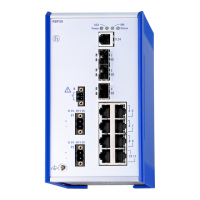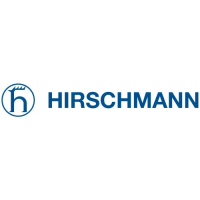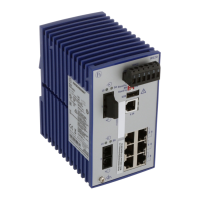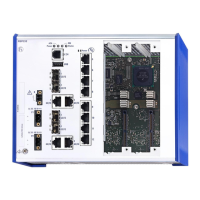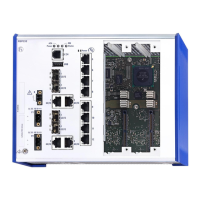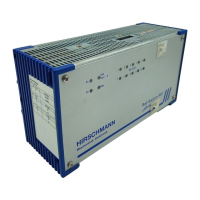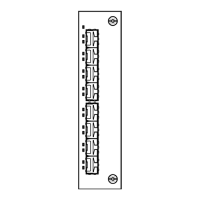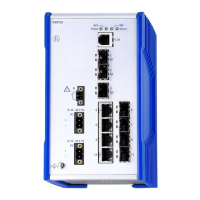
Do you have a question about the Hirschmann RSP 25 and is the answer not in the manual?
| Brand | Hirschmann |
|---|---|
| Model | RSP 25 |
| Category | Switch |
| Language | English |
Provides essential safety precautions for operating the device with electricity and handling it properly.
Defines the scope of certified usage, emphasizing use only as described and according to technical specifications.
Specifies requirements for installation locations, including fire enclosures and restricted access areas.
Rules for opening the device casing, inserting objects, and maintaining ventilation for proper air circulation.
Outlines the characteristics of qualified personnel required for safe handling, grounding, and labeling of the device.
Emphasizes the need to verify electrical installations meet national and international safety regulations.
Details the correct procedures for grounding the device and connecting shielding for safety.
Lists essential requirements to verify before connecting electrical wires to the device.
Details ATEX directive regulations for RSP devices in explosive gas atmospheres, including standards, labeling, and temperature codes.
Provides guidance and warnings for using RSP devices in Class I, Division 2 hazardous locations.
Specifies wiring, grounding, and warnings for devices used in Class I, Division 2 hazardous locations.
Covers IECEx certification for RSP devices, including standards, labeling, and environmental conditions.
Explains CE marking and compliance with EU directives (EMC, RoHS, LV) for industrial use.
Details safety standards for LED or LASER components, classifying them as Class 1 products.
Details FCC part 15 compliance for Class A digital devices and potential interference issues.
Provides guidelines for the proper disposal of the device as electronic waste.
Describes the content covered in this manual and lists other available Hirschmann documentation.
Defines the symbols used in the manual for listings, work steps, and subheadings.
Provides an overview of the RSP 20/25/30/35 devices, their industrial automation suitability, and customization options.
Explains how device names and product codes are structured, detailing characteristic values and their meanings.
Details the front view of the device, identifying ports, interfaces, status LEDs, and connection terminals.
Details the rear view of the device, highlighting the SD card slot and mounting features.
Covers the specifications for different power supply unit types (K9, KK, TT, CC) and their connection requirements.
Describes the 10/100 Mbit/s and 100/1000 Mbit/s Ethernet ports, including their capabilities and SFP slot usage.
Explains the meaning of various LEDs on the device indicating its operational status and port link status.
Details the V.24 serial interface and SD card interface for device management, configuration, and software updates.
Describes the potential-free relay contact used for remote diagnostics and signaling device events.
Instructions for checking the package contents and inspecting for transport damage.
Steps for installing an optional AutoConfiguration Adapter ACA31 storage medium.
Provides safety warnings and instructions for installing the device onto a DIN rail and grounding it.
Instructions for installing an optional Hirschmann SFP transceiver into the device's slot.
Details the connection procedures for supply voltage via terminal blocks for different characteristic values (K9, KK, CC, TT).
Instructions on how to ground the device, secure connectors, and enable the supply voltage for operation.
Recommendations for connecting data cables in environments with high electrical interference.
Guidance on filling out the inscription label for IP address identification of the device.
Details methods for configuring IP addresses, including V.24, HiDiscovery, BOOTP, DHCP, and AutoConfiguration Adapter.
Lists the default settings for IP address, management password, V.24 data rate, and Ethernet/TP port configurations.
Explains software upgrade options based on the device's software version and level, including HiOS availability.
Advises operating the device below the maximum specified ambient air temperature and explains internal vs. ambient temperature.
Highlights the device's design to minimize wear and tear, and the natural wear of relays based on switching operations.
Recommends checking for updated software versions and provides information on where to find downloads on Hirschmann pages.
Advises checking ventilation slots for obstructions due to environmental pollution at regular intervals.
Provides safety warnings and step-by-step instructions for safely disconnecting and removing the device from the DIN rail.
Describes the procedure for safely removing an SFP transceiver from its slot using the locking mechanism.
Presents general technical data, including device dimensions and weight for different variants.
Lists maximum power consumption and power output values for various RSP device models and supply voltage types.
Provides detailed dimension drawings of device variants with different operating temperature characteristics (S vs. E/T).
Details EMC interference emission and immunity test results according to various industry standards for standard and substation applications.
Specifies network range capabilities for fiber optic ports (SFP transceivers), including fiber types, attenuation, and dispersion.
Lists the standard scope of delivery, order numbers for accessories like terminal blocks, cables, and SFP transceivers.
Lists various Canadian, US, European, and international standards that the device complies with or is tested against.
Provides contact information for technical questions, including dealer addresses, support websites, knowledge bases, and software downloads.
Details services offered by the Competence Center, including consulting, training, and support for installation and maintenance.
